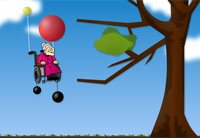


Alex spent a fair amount of time as a youth, playing coin operated arcade machines. These machines had one thing in common, little to no instructions!
You put your money in and just seconds later you were playing the game. This is something we aim for in our games, where possible we design the games so a casual gamer can just dive in and play. It was this design goal that prevented us progressing as planned.
We had planned to have 2 or 3 balloons hooked up to the wheelchair. You can pump helium in to expand a balloon and cause the whole contraption to rise, and you can let helium out causing the balloon to shrink and the lady and wheelchair to descend.
You can't be sure someone has 3 mouse buttons, so when using Adobe Flash you really only have one mouse button to play with. How do we intuitively switch between pumping the gas in and letting gas out?
We tried a. icons that you drag onto the balloons, b. a toggle button for inflate and deflate, and c. a popup menu on the balloons when you click them. None of these 3 solutions felt right, it seemed like a chore to have this extra process involved.
Other things we tried were a. clicking one side of a balloon to inflate and the other to deflate, and b. click on the balloon to inflate and on a valve to deflate. These didn't feel like such a chore but we were unconvinced the mechanism would be obvious to those who jumped right in without reading any instructions.
Our solution was to scrap the idea of balloons being able to deflate. Balloons would inflate only, causing the contraption to rise. The introduction of weights hanging down as ballast, which could be increased in size causing the contraption to descend would solve our problem.
As soon as we tested this it felt much better. It may not be scientifically possible in real life, but it is in cartoon world!
The first video clip shows the game at this stage of development. The lady rises up out of view as we hadn't programmed the camera to follow her up. At this early stage of development it was just a fixed camera.
We quickly added the camera tracking so the game view followed the old lady as she ascended and descended. We also added some of the scenery we had already prepared, so you could tell the speed and direction she was moving. This is when we found our next problem.
You probably will not be able to sit through the next video clip. This was the problem, too long between inflating a balloon or increasing a weight and seeing the result.
This was solved by varying the speed at which our contraption moved. The further away from its final resting place the faster it moves, the closer it gets to its final resting place the slower it moves.
This gave a realistic movement, and the time between player interaction was much improved.
We had our graphics, and we had our contraption working perfectly, next we had to figure out the finer points of the game. How the scoring system should work, and how to create levels. This will be our topic for the next part or this article.